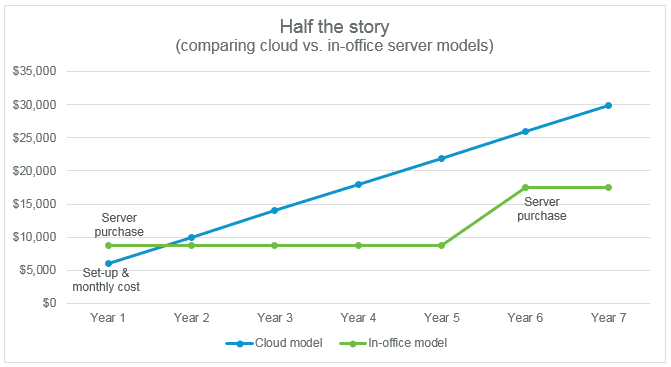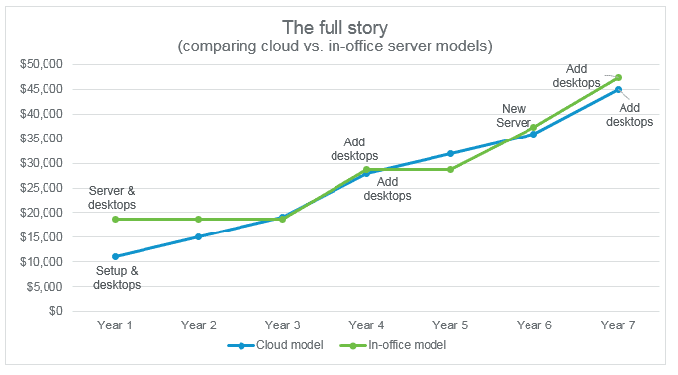When businesses first start examining a cloud solution, I am fully prepared for the response that comes without fail—“it’s going to cost too much.”
All of the organizations that I know who have looked at a cloud solution, but decided not to act, have told me that they understand the enhancements and benefits of moving to the cloud, but they just can’t justify the expense. There’s only one problem with that rationale. It’s incorrect.
The numbers
It’s almost always more cost effective for a business to move to a cloud-based office than to continue with the traditional in-office server model or even a hybrid server/cloud solution. While the numbers for an office in the cloud certainly look daunting, they don’t always tell the full story.
A friend of mine reached out to me after reading my blog about virtual desktops and asked about possible cloud solutions for his business. As any smart business owner would, he did his due diligence on pricing first. His concern was similar to others. “Looking at the numbers, this solution doesn’t seem to make financial sense,” he said.
I asked for the numbers he’s working with and here’s what he gave me. The graph below shows the annual cost for seven years for both the cloud model and in-office server model. By simply evaluating cloud versus in-house servers, you would conclude that it’s more cost effective to stick with the in-office server model.

Half the story
The numbers my friend was looking at showed that it was less expensive to maintain a local server than to move his office to the cloud. However, as I informed him, he’s only seeing half of the story.
The remaining part of the story is told in the devices that his staff use each day. One big difference is the technology used to access the server is not represented in the chart. In a traditional server environment, the desktops require a powerful processor and significant memory for each user to have a functional machine that is able to meet their needs. In a cloud office, that processor and memory are all being utilized in the cloud. For cloud users, the computer is now just a tool to connect to their actual desktop in the cloud; therefore, it doesn’t need to be an expensive workhorse machine.
Additionally, cloud computers no longer need to be a member of a domain and no longer have the requirement to run the professional version of an operating system on each machine. As a result, overall desktop costs are cut in half in the cloud model.
The full picture
It’s time to look at the scenario in a new way. This illustration demonstrates an office with 10 computers that are replaced every three years per industry standards. Like the previous graph, hardware and server licensing are not purchased every year.

The bottom line
When looking at the cost savings for computers, you can see the shift that occurs to the total cost savings of the cloud solution. Machines will typically last longer than the four-year average because they are only being used to connect to the cloud, and not to do all the processing, thereby creating even more savings.
The financial benefits can be expanded even further if your office licensing is bundled into your cloud solution. Backup costs can either be eliminated altogether or greatly reduced in a cloud -based scenario, making your office solution a much more expensive option.
Is your business a good candidate for moving to the cloud? Hopefully my series of cloud blogs provide you with enough information to help make an informed decision. Just be sure to see the whole story.
